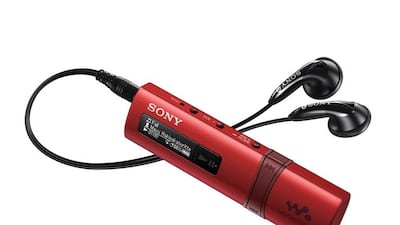From my menuless 1GB Apple iPod Shuffle I learnt how music could improve your life. I walked with it on the beaches of Waiheke Island in New Zealand, and listened to Maps from The Yeah Yeah Yeahs’ 2003 album Fever to Tell on repeat. That was in 2005.
Sony’s 4GB Walkman MP3 music player, released earlier this year, doesn’t look like a considerable improvement over the technology I enjoyed almost a decade ago.
Sony’s Walkman is a strange brand to update, synonymous as it is with a kind of out-of-date retro kitsch of hipster music-lovers repurposing obsolete kit to make an obscure point about progress and late capitalism. To less jaded folk, it brings to mind the tape player, the VHS, the Betamax, the 3.5” floppy disk, and the 56KB dial-up connection – or, less kindly, a monumental pile of technological detritus built out of devices that no longer have a purpose – shoebox-sized mobile phones from the 1980s, desk-consuming CRT monitors, packages of unused talk-and-type software, and the like.
Looking at Sony’s new Walkman, it’s not immediately obvious what the difference in functionality is between this product and the one I owned in 2005. The Walkman has a searchable menu, it has a capacity of 4GB and a radio player.
That is to say, it looks like a USB key, albeit a shiny-ish one. Which means it’s fine for gym work, although I wouldn’t trust it to be caked in sweat in 40° heat.
The main issue with cheap USB key MP3 players is that it’s hard to navigate your music.
This isn’t an issue with properly labelled tracks on the Walkman, as there’s a small screen – although it’s not quite as easy to search as a full-sized iPod.
It’s also worth pointing out that audio quality does not vary with the cost of the MP3 player – the hardware you use, and the bitrate of the recording, determine how good it sounds. So there’s no reason to spend a lot of money on an expensive player, besides memory and user interface.
At Dh180, this is not a high-end product – it’s cheap and cheerful, if basically a slightly upgraded version of the product I took to New Zealand with me aged 15.
Turn up the bass
What’s special about this Walkman?
This product also has a bass-enhancement button. The idea here is that low-quality earphones, especially if not positioned properly in your ear, won’t properly play the lower frequency ranges of tracks. So bass boosters should help you if you’re listening to the track on the earphones with which the product was packaged. A much better solution, however, is to buy a better pair of headphones. You’ll get a much better listening experience.
But isn’t more bass always good?
There’s this Neanderthal prejudice, often evidenced in genres spawned from and influenced by British garage – drum ‘n’ bass, dubstep, breaks – that more bass is always a good thing. But I’ve seen far too many otherwise intact speaker systems ruined, and eardrums popped, by overexcited turns of the bass knob on a DJ’s three-band equaliser to subscribe to this school of thought.
Can you expand on your theory?
Some producer somewhere has been paid a chunk of money to think about how levels should be balanced – so, turning up the bass on a George Martin-produced track, for instance, would be to miss the point. On the other hand, for most dance or reggae music, headphones aren’t going to be able to replicate the effect of a wall of Marshall stacks and industry-strength monitors. So you could be forgiven for turning up the bass a tad when King Tubby comes calling.
abouyamourn@thenational.ae
Follow us on Twitter @Ind_Insights

